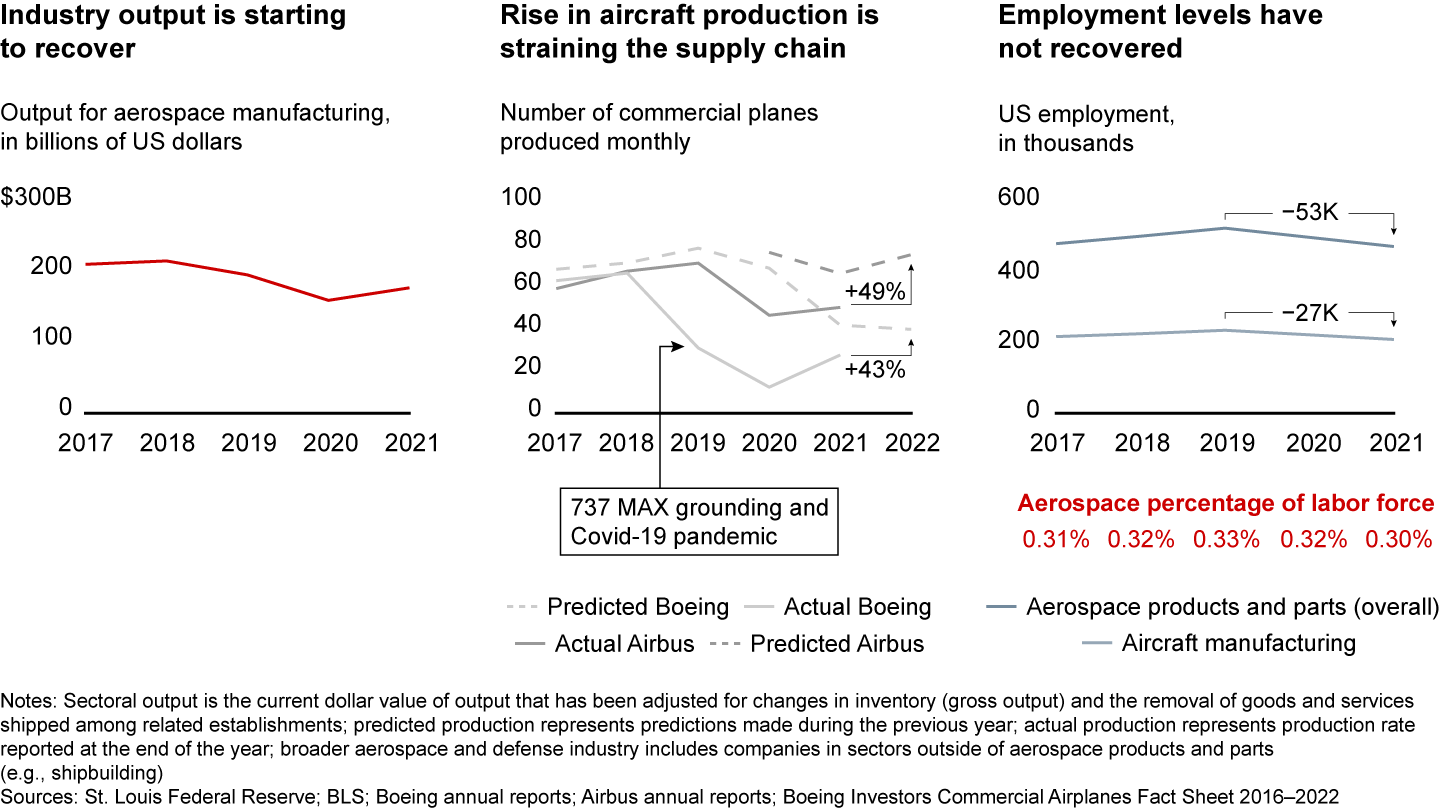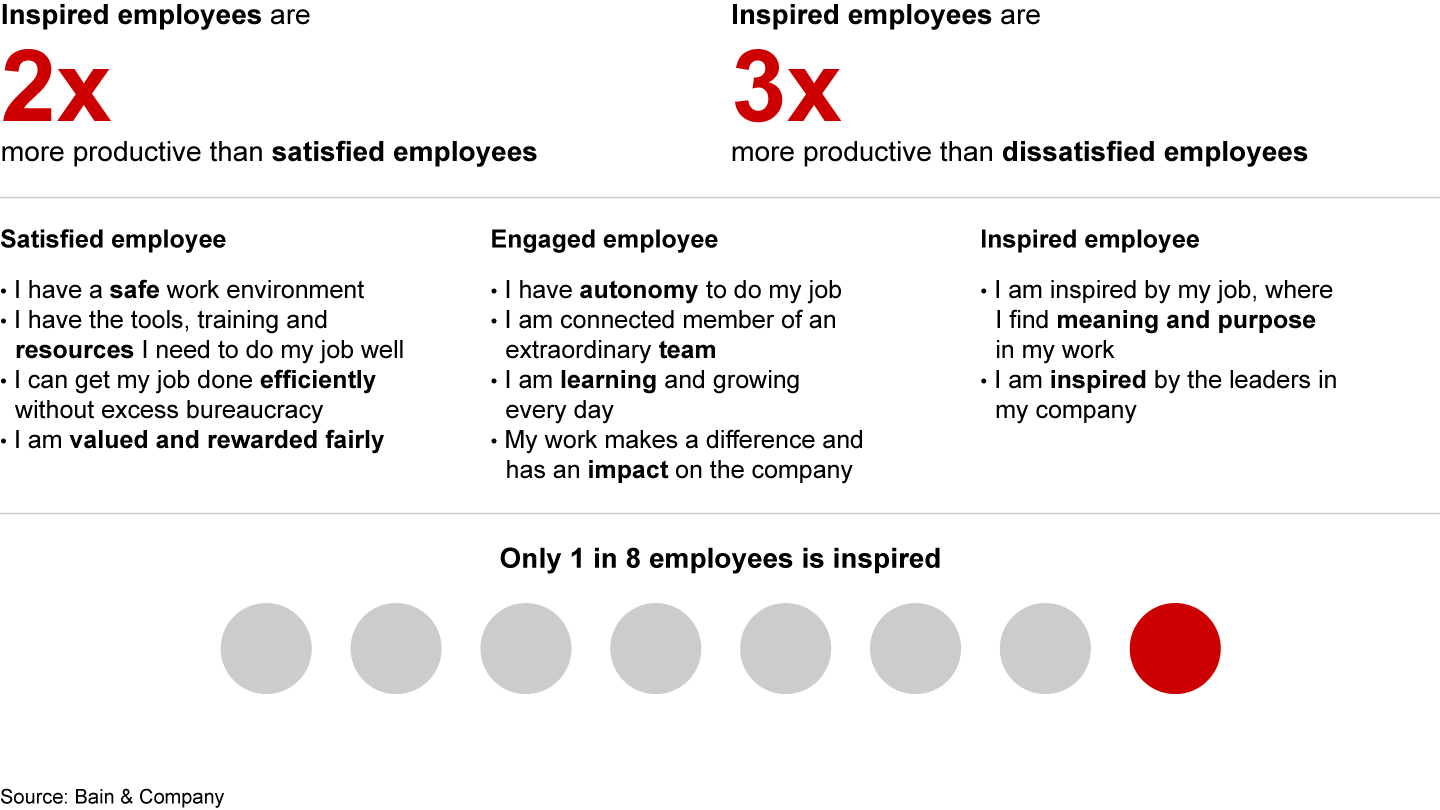Brief

At a Glance
- Bain research shows that engineers spend only 50% of their time on engineering work and 40% on lower-value activities.
- Top aerospace and defense companies continually review mature programs and redeploy top talent to development programs.
- To keep talent engaged, eliminate unnecessary processes, oversight, and low-value work that robs people of purpose.
While most industries are anticipating recession and slower growth, aerospace and defense (A&D) sectors are still buoyed by relatively robust demand. The challenge for A&D is hiring the technical and frontline talent to meet that demand. A recent Bain study found that the US manufacturing sector is still lacking 500,000 to 800,000 workers, with a shortfall of more than 50,000 in A&D (see Figure 1).

Resolving this labor gap will be a key challenge for the A&D industry in the coming decade. Given an aging workforce and the cyclical nature of new program-centric growth, companies must be able to address both the supply and the demand side of labor to bring the industry into balance.
Free up talent with zero-based redesign
A zero-based redesign (ZBR) of activities can be a powerful tool to address the demand side of the talent equation. ZBR is a systematic approach to eliminate low-value, duplicative work by rethinking from scratch what activities are needed to design processes. Through elimination, simplification, and automation, companies can free up talent for critical activities while improving efficiency.
While most companies find inefficiencies in general and administrative functions, it is critical to look beyond the back office to other core A&D functions. For instance, in order to boost investment in the software development capabilities needed to win on future programs, a company might automate lower-value internal processes that often frustrate technical employees.
Engineering is the lifeblood of A&D innovation, and leading companies seek opportunities to reinvent this work. A recent Bain study found that engineers spend only 50% of their time on engineering work, while 40% of their time is spent on lower-value activities. ZBR can help to free up pools of scarce talent to focus on the highest-value activities. This can lead to win-wins, improving employee satisfaction and delivering better results to the bottom line.
Even customer-facing functions such as business development can benefit from redesign. Examples include better leveraging of internal data to improve, reuse, and automate the proposal process; leveraging software and tools to more centrally manage customer relationships; and streamlining bureaucratic and time-consuming processes. All are opportunities to increase the amount of time business development talent spends on customer-facing interactions compared with internal reviews and busywork.
A focused ZBR program can have enormous benefits across the organization, from back-office to customer-facing functions. By ensuring that redesign efforts are rooted in a deep understanding of employee pain points and the customer value proposition, leadership teams can maximize the benefit to both employees and customers. Changing how employees work frees talent capacity and improves retention and recruitment efforts for critical roles.
Unlock workforce productivity
Leadership teams at top-performing A&D companies make sure that their talent is deployed effectively. That entails strategically deploying individuals to the highest areas of value, investing in long-term talent development, and increasing employee engagement by focusing on purposeful work.
Most organizations can deploy their highly skilled workers more strategically. Those with specialized skills are often trapped in long-standing roles that don’t make the most of their abilities. Leading companies look to fill these positions with lower-skilled employees, especially when the demand for higher-level skills can’t be filled. They also leverage artificial intelligence tools to create detailed skills inventories of their workforce, allowing them to help redeploy individual talent to best use within the company.
All too often, companies keep top talent working on well-performing mature programs rather than on new development critical to the future of the company. Much like capital, talent should be deployed where it can have the greatest return and impact. Leadership teams can continually review the level of engineering support on mature programs as a potential source of top talent that may be more productive in a new assignment.
Successful A&D companies take a long-term view of talent, rethinking and reinforcing investments in learning and development to help current and future employees build skills vital to their careers. They also embrace approaches like career-connected learning, which includes partnering with local governments and educational institutions to help create tailored training and apprenticeship programs. For instance, Boeing hires college sophomores majoring in engineering to work part time as part of their Accelerated Leadership Program, offering the opportunity for scholarships and full-time positions to the most promising candidates.
Importantly, inspired employees are twice as productive as merely satisfied employees and three times as engaged as dissatisfied employees (see Figure 2). And purposeful work inspires employees. Connecting what employees are doing to the broader mission of the company and its customers can seem fairly straightforward in A&D. Meetings with customers often include inspiring stories of how products may have affected lives or even saved lives. Autonomy and empowerment also give employees a greater sense of purpose.

Leading A&D companies systematically eliminate unnecessary processes, oversight, and low-value work that robs people of purpose, and they make sure that employees feel greater engagement and inspiration. In addition, they take a long-term view of talent as an investment, developing and deploying talent to maximize returns over employees’ careers.
Create a virtuous circle
Resolving the labor gap in A&D means addressing both the demand and the supply side of the talent equation. Eliminating low-value work frees capacity and increases engagement, which can be a powerful tool to retain talent. And improvements to the supply side can lead to more motivated and productive talent, creating a virtuous circle improving the overall performance of the company, including through reduced inefficiencies like rework.
A talented and engaged workforce can make the difference between winning and losing. That’s why managing talent shouldn’t be relegated to HR alone. CEOs and their leadership teams can gain a competitive edge by making team productivity, employee loyalty, and employee retention top priorities.

